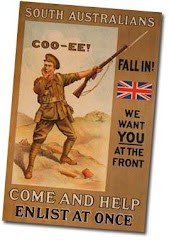 Fred Jones was the fifth child of Edwin Elliott Jones and Annie Jones (nee Wait). He was born at Glen Osmond in 1888, and his father died four years later when Fred was just 4. He attended Coromandel Valley Public School and the family were active in the Coromandel Valley Methodist Church. Fred was honorary secretary of the Blackwood Rifle Club and a member of the Blackwood, Belair and Coromandel Valley Boy's Club. Like many young men at the time, Fred chased work wherever he could find it, including breaking rocks for council road-making in the district. He enlisted on 28 August 1914, and the September 1914 issue of the Blackwood Magazine noted that he was amongst the first men to enlist from the area.
Fred Jones was the fifth child of Edwin Elliott Jones and Annie Jones (nee Wait). He was born at Glen Osmond in 1888, and his father died four years later when Fred was just 4. He attended Coromandel Valley Public School and the family were active in the Coromandel Valley Methodist Church. Fred was honorary secretary of the Blackwood Rifle Club and a member of the Blackwood, Belair and Coromandel Valley Boy's Club. Like many young men at the time, Fred chased work wherever he could find it, including breaking rocks for council road-making in the district. He enlisted on 28 August 1914, and the September 1914 issue of the Blackwood Magazine noted that he was amongst the first men to enlist from the area.He joined B or 'Beer' Company of the 10th Battalion at Morphettville, and shipped out with the rest of the battalion on the 'Ascanius' on 20 October 1914. By December 1914 the battalion was camped in tents at the foot of the Pyramids in Egypt. Training continued till early April 1915 when the battalion moved to Alexandria and then to the island of Lemnos in the Aegean Sea.
About 2pm on the afternoon of 24 April 1915, Fred, loaded down with his pack and rifle, climbed on board the British battleship the 'Prince of Wales', along with the rest of 'Beer' and 'Cork' companies of the 10th Battalion. The 'Prince of Wales' then slipped out of Mudros Harbour, along with other ships carrying the rest of the first wave that was to land on Gallipoli.
Around 7pm that evening the battalion were told they could rest until 11pm. Those that were able to sleep were woken at midnight, and they were all given a welcome cup of hot cocoa by the ships' crew.
At 1am the ships stopped so the soldiers could start climbing down rope ladders into lines of rowing boats moored alongside the battleship. By 2.35am the rowing boats were full, and the battleship set off again with the lines of rowing boats attached to its sides. At 3 am the moon set and the sky grew very dark. At 3.30am the boats cast off from the battleship to be towed in threes towards the distant shore by small steamboats.
It was so dark that they would probably not have been able to see the lines of boats being towed alongside. Perhaps they could have just made out the boat behind or in front. The water was smooth as satin. It was a cool peaceful night. There was still no sign of any sort that the Turks had seen them. Close to the shore, the steamboats cast off the lines of boats, and they began to row.
About 4.29am a figure appeared silhouetted on a cliff overlooking the beach and a shot rang out, whizzed overhead and plunged into the sea. Moments later, as the boats reached the stony beach, Fred and his mates slipped over the side and waded ashore, weighed down by their equipment. Bullets struck sparks off the stones on the beach, and men were killed and wounded in the boats, in the water and on the beach. Those that hadn’t been hit ran across the stony beach to the cover of a sandy bank. They started to scale the steep hill in front of them, some driving their bayonet into the dirt to give them a handhold, as the Turks kept shooting at them with rifles then machine guns, the fire getting heavier and the casualties mounting every minute.
Sometime in the next few days of confused fighting, Fred Jones was seriously wounded. On 1 May 1915 at sea aboard the 'Derfflinger', he died. He was buried the following day at the Chatby War Memorial Cemetery, Egypt. He was the first man from Coromandel Valley to die as a result of enemy action in the First World War. He is commemorated on the family grave in the Coromandel Valley Cemetery, on the Coromandel Valley Public School Roll of Honour, at the Coromandel War Memorial, and in the South Australian National War Memorial.
His younger brother Perc enlisted in January 1916, served in the Middle East with the 9th Light Horse Regiment and survived the war.







No comments:
Post a Comment